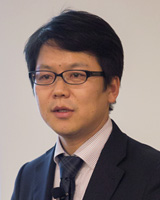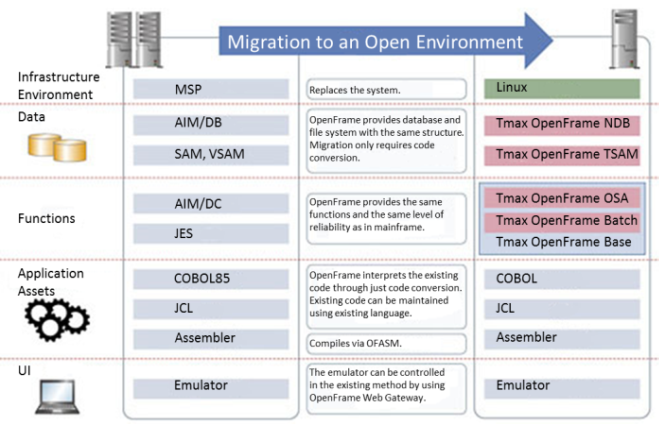
| Press | TmaxSoft Japan: Rapid and Low Cost Migration of Mainframe Applications and Services to an Open Environment without Redevelopment | 2015-06-01 |
|---|
Original Article: IT Pro http://special.nikkeibp.co.jp/ts/article/ae0e/181249
IT Modernization Summit (2015.04.23) Review Article
[TmaxSoft Japan]
Rapid
and Low Cost Migration of Mainframe Applications and Services to an Open Environment
without Redevelopment
As information systems have become an
essential component for business management, migration of existing mainframe
applications and services to an open environment without redevelopment has also
become an important task. TmaxSoft Japan’s OpenFrame enables the implementation
of business and application logics without redevelopment effort, in a short
period of time, and at low cost.
Large Number of Cases Involving Mainframe
Migration to an Open Environment

“Don’t you think that fear is the main
reason for resisting migration?” asks Jongpil Ra, the Vice President of
TmaxSoft Japan. Of course there are other reasons such as cost and difficulty
in building consensus within the company and finding engineers confident to
carry out the task. “I think that setting a clear migration policy will mainly
influence the company’s decision for migration,” says Vice President Ra.
TmaxSoft Japan is the Japanese
subsidiary of TmaxSoft. Its main products are middleware solutions including JEUS
web application server, Tmax WebtoB web server, and Tibero RDBMS.
JEUS enjoys a high market share in the
domestic market, surpassing Oracle and IBM. In Japan, TmaxSoft provides
various middleware products including its flagship product Tmax OpenFrame, a
mainframe rehosting solution. So far, more than 10 large-scale mainframe migration
cases have been implemented in Japan.
OpenFrame enables migration of mainframe
applications and services to an open system environment, such as Linux, without
redevelopment. The entire system can be migrated without modifying business and
application logics. Since OpenFrame configuration module runs on a TP monitor,
OpenFrame is capable of hosting a next generation system.
Furthermore, OpenFrame can migrate COBOL,
PL/1, and JCL applications without any modification while maintaining their
functionality. It supports the reuse of mainframe data sources, automated
migration analysis, execution, and verification processes, and reliable transaction
processing using its own proprietary technology. OpenFrame also reduces the
cost, time, and effort required for the conversion process, which helps reduce
the amount of time and cost spent on developing a next generation infrastructure.
■ Total Solution, OpenFrame
OpenFrame
provides an environment that can maximize high performance, reliability,
flexibility, and scalability.

Migrated 50,000 Mainframe Assets in
Just 17 Months
A successful migration of 50,000
mainframe assets in just 17 months during the rehosting project for company “A”
has helped prove OpenFrame’s powerful performance. The total number of assets
for migration exceeded 10 million including 4,000 admin/business screens, 100
core assembly apps, 9,000 ledgers, etc. Other requirements involved developing
a web-based emulation terminal, adopting vendor independent peripheral devices,
etc.
“OpenFrame provides the five core technologies
(character code conversion, database, middleware, compiler, and WAS) required
for a successful mainframe migration,” says Vice President Ra.
In the aforementioned large-scale
migration project, OpenFrame was selected for its use in many core system
migration projects, and its ability to flexibly respond to functional enhancement
requirements and migrate middleware and functions provided by various vendors
without modification.
“Automatic conversion can be applied to online
processing via AIM/DCMS, (online/document print function on TSS screen), AIM/NDB
(network DB) management, command groups such as OS commands, JES functions, JES
commands, AIM commands, and various utilities provided by each vendor. We have
received positive feedbacks for automated conversion of assembler program/SVC
function supported in OpenFrame,” says Vice President Ra.
The benefits of mainframe migration
are numerous. Migration can enable the reuse of existing software assets, and reduce
the core system operation cost. In an open environment, the system can be
configured using the latest technology. This allows for easy integration with
other systems, easy system modification, and easy expansion. In addition, near
real-time processing can be supported by reducing the lag time on the host
system. Distributed data can be managed in RDBMS, which allows many departments
within a company to share the same database. The biggest benefit is the ability
to build a roadmap for core system redevelopment. In an open environment, companies
no longer need to be concerned about discontinued support from vendors.
■ Migration Schedule of Company “A”
Implemented each engineering process of planning, analysis, and migration
phases for its core system within 17 months.

Scheduled Release of OpenFrame 7.0 in
2015 to Maximize Flexibility and Scalability
TmaxSoft Japan is planning to release
the latest version (OpenFrame 7.0) by September of this year. OpenFrame 7.0 is
designed with a standard architecture, and it supports easier development of
next generation systems, and maximized flexibility and scalability. It also
provides enhanced automated migration and testing functionalities that can greatly
reduce the project time period and cost. It can also fully integrate with various
3rd party products. By using ODBC, OpenFrame 7.0 can connect to any
RDBMS and use DB connections more efficiently compared to OpenFrame 6.0.
“Due to growing competition, companies
are pressured to increase their competitiveness by efficiently utilizing their limited
management resources. This necessitates the migration of mainframe-based legacy
systems to gain flexibility and reduce operational cost,” says Vice President
Ra. TmaxSoft Japan will strive to continually contribute to modernizing IT infrastructure
in Japan.